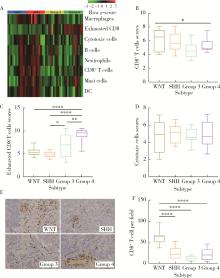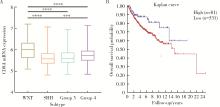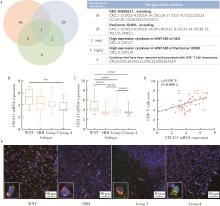北京大学学报(医学版) ›› 2024, Vol. 56 ›› Issue (3): 512-518. doi: 10.19723/j.issn.1671-167X.2024.03.019
髓母细胞瘤分子亚型中CD8+T淋巴细胞浸润的临床病理特点
柴晓东1,2,孙子文1,李海爽1,朱靓怡1,刘小旦1,2,刘延涛1,裴斐1,2,*( ),常青3,*(
),常青3,*( )
)
- 1. 北京大学第三医院病理科, 北京 100191
2. 北京大学基础医学院病理学系, 北京 100191
3. 北京市神经外科研究所神经病理中心, 北京 100070
Clinicopathological characteristics of the CD8+ T lymphocytes infiltration and its mechanism in distinct molecular subtype of medulloblastoma
Xiaodong CHAI1,2,Ziwen SUN1,Haishuang LI1,Liangyi ZHU1,Xiaodan LIU1,2,Yantao LIU1,Fei PEI1,2,*( ),Qing CHANG3,*(
),Qing CHANG3,*( )
)
- 1. Department of Pathology, Peking University Third Hospital, Beijing 100191, China
2. Department of Pathology, Peking University School of Basic Medical Sciences, Beijing 100191, China
3. Department of Molecular Neuropathology, Beijing Neurosurgical Institute, Beijing 100070, China
摘要:
目的: 研究CD8+T细胞在髓母细胞瘤(medulloblastoma, MB)各个分子亚型中的浸润特点,分析CD8+T细胞浸润与患者预后的关系,以及C-X-C基序趋化因子11(C-X-C motif chemokine ligand 11)的表达及其受体CXCR3在CD8+ T细胞中的表达情况,为进一步探索MB中CD8+T细胞浸润可能的调节机制提供临床病理依据。方法: 筛选2012—2019年间来自多所医学中心、具有完整临床资料的MB患者共48例(4个分子亚型各12例),利用NanoString PanCancer IO360TM基因表达检测平台对48例MB患者的肿瘤标本进行转录组学分析,对患者肿瘤组织的石蜡切片进行CD8免疫组织化学染色分析,验证各亚型MB中CD8+T细胞数量的差异。通过数据库生物信息学分析,探讨CD8+T细胞浸润与患者预后的关系及各种趋化因子在各亚型MB中的表达差异,并采用双重免疫荧光染色验证MB中CD8+T细胞表面CXCR3受体的表达情况,探讨CD8+T细胞浸润至肿瘤内的可能分子机制。结果: MB的WNT亚型中的CD8+T细胞特征指数相对较高,提示WNT亚型中的CD8+T细胞数量显著高于其他三个亚型,这一现象通过CD8免疫组织化学染色方法以及R2在线数据分析平台对美国基因表达数据库Gene Expression Omnibus (GEO)进行数据挖掘得到了证实,且CD8+T细胞增多与患者的生存期呈正相关。数据库分析显示,CXCL11在WNT亚型MB中的表达量明显高于其他三个亚型。免疫荧光染色结果显示,CD8+T细胞表面存在CXCL11的受体CXCR3,提示CD8+T细胞可能通过表面受体CXCR3受CXCL11趋化至MB的微环境中。结论: CD8+T细胞在WNT亚型MB中的浸润相对多于其他亚型,其机制可能与CXCL11-CXCR3趋化因子系统的激活相关,且肿瘤内CD8+T细胞浸润较多的患者预后较好,此结果可能为MB中CD8+T细胞浸润调节机制提供有益的临床病理依据,为未来MB的免疫治疗提供新的潜在治疗靶点。
中图分类号:
- R739.41
| 1 | Ostrom QT , Cioffi G , Gittleman H , et al. CBTRUS statistical report: Primary brain and other central nervous system tumors diagnosed in the United States in 2012-2016[J]. Neuro Oncol, 2019, 21 (Suppl 5): v1- v100. |
| 2 | Ostrom QT , Cioffi G , Waite K , et al. CBTRUS statistical report: Primary brain and other central nervous system tumors diagnosed in the United States in 2014-2018[J]. Neuro Oncol, 2021, 23 (12 Suppl 2): iii1- iii105. |
| 3 |
Wen PY , Packer RJ . The 2021 WHO classification of tumors of the central nervous system: Clinical implications[J]. Neuro Oncol, 2021, 23 (8): 1215- 1217.
doi: 10.1093/neuonc/noab120 |
| 4 |
Szalontay L , Khakoo Y . Medulloblastoma: An old diagnosis with new promises[J]. Curr Oncol Rep, 2020, 22 (9): 90.
doi: 10.1007/s11912-020-00953-4 |
| 5 |
Stadskleiv K , Stensvold E , Stokka K , et al. Neuropsychological functioning in survivors of childhood medulloblastoma/CNS-PNET: The role of secondary medical complications[J]. Clin Neuropsychol, 2022, 36 (3): 600- 625.
doi: 10.1080/13854046.2020.1794045 |
| 6 |
Vatner RE , Niemierko A , Misra M , et al. Endocrine deficiency as a function of radiation dose to the hypothalamus and pituitary in pediatric and young adult patients with brain tumors[J]. J Clin Oncol, 2018, 36 (28): 2854- 2862.
doi: 10.1200/JCO.2018.78.1492 |
| 7 |
Hu M , Huang L . Strategies targeting tumor immune and stromal microenvironment and their clinical relevance[J]. Adv Drug Deliv Rev, 2022, 183, 114137.
doi: 10.1016/j.addr.2022.114137 |
| 8 |
Bockmayr M , Mohme M , Klauschen F , et al. Subgroup-specific immune and stromal microenvironment in medulloblastoma[J]. Oncoimmunology, 2018, 7 (9): e1462430.
doi: 10.1080/2162402X.2018.1462430 |
| 9 |
Grabovska Y , Mackay A , O'Hare P , et al. Pediatric pan-central nervous system tumor analysis of immune-cell infiltration identifies correlates of antitumor immunity[J]. Nat Commun, 2020, 11 (1): 4324.
doi: 10.1038/s41467-020-18070-y |
| 10 |
Riemondy KA , Venkataraman S , Willard N , et al. Neoplastic and immune single-cell transcriptomics define subgroup-specific intra-tumoral heterogeneity of childhood medulloblastoma[J]. Neuro Oncol, 2022, 24 (2): 273- 286.
doi: 10.1093/neuonc/noab135 |
| 11 | Diao S , Gu C , Zhang H , et al. Immune cell infiltration and cytokine secretion analysis reveal a non-inflammatory microenvironment of medulloblastoma[J]. Oncol Lett, 2020, 20 (6): 397. |
| 12 |
Colvin RA , Campanella GS , Sun J , et al. Intracellular domains of CXCR3 that mediate CXCL9, CXCL10, and CXCL11 function[J]. J Biol Chem, 2004, 279 (29): 30219- 30227.
doi: 10.1074/jbc.M403595200 |
| 13 |
Karin N . CXCR3 ligands in cancer and autoimmunity, chemoattraction of effector T cells, and beyond[J]. Front Immunol, 2020, 11, 976.
doi: 10.3389/fimmu.2020.00976 |
| 14 |
Vollmer T , Schlickeiser S , Amini L , et al. The intratumoral CXCR3 chemokine system is predictive of chemotherapy response in human bladder cancer[J]. Sci Transl Med, 2021, 13 (576): eabb3735.
doi: 10.1126/scitranslmed.abb3735 |
| 15 |
Liu C , Zheng S , Wang Z , et al. KRAS-G12D mutation drives immune suppression and the primary resistance of anti-PD-1/PD-L1 immunotherapy in non-small cell lung cancer[J]. Cancer Commun (Lond), 2022, 42 (9): 828- 847.
doi: 10.1002/cac2.12327 |
| 16 |
Li Y , Han S , Wu B , et al. CXCL11 correlates with immune infiltration and impacts patient immunotherapy efficacy: A pan-cancer analysis[J]. Front Immunol, 2022, 13, 951247.
doi: 10.3389/fimmu.2022.951247 |
| 17 |
Chen Q , Jin J , Huang X , et al. Emp3 mediates glioblastoma-associated macrophage infiltration to drive T cell exclusion[J]. J Exp Clin Cancer Res, 2021, 40 (1): 160.
doi: 10.1186/s13046-021-01954-2 |
| 18 |
Zhu L , Yang Y , Li H , et al. Exosomal micrornas induce tumor-associated macrophages via ppargamma during tumor progression in SHH medulloblastoma[J]. Cancer Lett, 2022, 535, 215630.
doi: 10.1016/j.canlet.2022.215630 |
| 19 |
Margol AS , Robison NJ , Gnanachandran J , et al. Tumor-associa-ted macrophages in SHH subgroup of medulloblastomas[J]. Clin Cancer Res, 2015, 21 (6): 1457- 1465.
doi: 10.1158/1078-0432.CCR-14-1144 |
| 20 |
Gao Q , Wang S , Chen X , et al. Cancer-cell-secreted CXCL11 promoted CD8(+) T cells infiltration through docetaxel-induced-release of HMGB1 in NSCLC[J]. J Immunother Cancer, 2019, 7 (1): 42.
doi: 10.1186/s40425-019-0511-6 |
| 21 |
Chen Z , Liu S , He C , et al. CXCL12-CXCR4-mediated chemotaxis supports accumulation of mucosal-associated invariant T cells into the liver of patients with PBC[J]. Front Immunol, 2021, 12, 578548.
doi: 10.3389/fimmu.2021.578548 |
| 22 |
Murdamoothoo D , Sun Z , Yilmaz A , et al. Tenascin-C immobilizes infiltrating T lymphocytes through CXCL12 promoting breast cancer progression[J]. EMBO Mol Med, 2021, 13 (6): e13270.
doi: 10.15252/emmm.202013270 |
| 23 |
Di Pilato M , Kfuri-Rubens R , Pruessmann JN , et al. CXCR6 positions cytotoxic T cells to receive critical survival signals in the tumor microenvironment[J]. Cell, 2021, 184 (17): 4512- 4530. e22.
doi: 10.1016/j.cell.2021.07.015 |
| 24 |
Abdulrahman Z , Santegoets SJ , Sturm G , et al. Tumor-specific T cells support chemokine-driven spatial organization of intratumoral immune microaggregates needed for long survival[J]. J Immunother Cancer, 2022, 10 (2): e004346.
doi: 10.1136/jitc-2021-004346 |
| 25 |
Safaei S , Mohme M , Niesen J , et al. Dimeimmune: Robust estimation of infiltrating lymphocytes in CNS tumors from DNA methy-lation profiles[J]. Oncoimmunology, 2021, 10 (1): 1932365.
doi: 10.1080/2162402X.2021.1932365 |
| 26 |
Pham CD , Flores C , Yang C , et al. Differential immune microenvironments and response to immune checkpoint blockade among molecular subtypes of murine medulloblastoma[J]. Clin Cancer Res, 2016, 22 (3): 582- 595.
doi: 10.1158/1078-0432.CCR-15-0713 |
| 27 |
Liu Z , Meng Q , Bartek J Jr , et al. Tumor-infiltrating lymphocytes (TILs) from patients with glioma[J]. Oncoimmunology, 2017, 6 (2): e1252894.
doi: 10.1080/2162402X.2016.1252894 |
| 28 |
Kim AR , Choi SJ , Park J , et al. Spatial immune heterogeneity of hypoxia-induced exhausted features in high-grade glioma[J]. Oncoimmunology, 2022, 11 (1): 2026019.
doi: 10.1080/2162402X.2022.2026019 |
| 29 |
Park J , Kwon M , Kim KH , et al. Immune checkpoint inhibitor-induced reinvigoration of tumor-infiltrating CD8(+) T cells is determined by their differentiation status in glioblastoma[J]. Clin Cancer Res, 2019, 25 (8): 2549- 2559.
doi: 10.1158/1078-0432.CCR-18-2564 |
| 30 |
Salsman VS , Chow KK , Shaffer DR , et al. Crosstalk between medulloblastoma cells and endothelium triggers a strong chemotactic signal recruiting T lymphocytes to the tumor microenvironment[J]. PLoS One, 2011, 6 (5): e20267.
doi: 10.1371/journal.pone.0020267 |
| 31 |
Yi J , Shi X , Xuan Z , et al. Histone demethylase UTX/KDM6A enhances tumor immune cell recruitment, promotes differentiation and suppresses medulloblastoma[J]. Cancer Lett, 2021, 499, 188- 200.
doi: 10.1016/j.canlet.2020.11.031 |
| 32 |
Gomes-Santos IL , Amoozgar Z , Kumar AS , et al. Exercise training improves tumor control by increasing CD8+ T-cell infiltration via CXCR3 signaling and sensitizes breast cancer to immune checkpoint blockade[J]. Cancer Immunol Res, 2021, 9 (7): 765- 778.
doi: 10.1158/2326-6066.CIR-20-0499 |
| 33 |
Zheng Y , Liu Y , Zhang F , et al. Radiation combined with KRAS-MEK inhibitors enhances anticancer immunity in KRAS-mutated tumor models[J]. Transl Res, 2023, 252, 79- 90.
doi: 10.1016/j.trsl.2022.08.005 |
| 34 |
Chheda ZS , Sharma RK , Jala VR , et al. Chemoattractant receptors BLT1 and CXCR3 regulate antitumor immunity by facilitating CD8+ T cell migration into tumors[J]. J Immunol, 2016, 197 (5): 2016- 2026.
doi: 10.4049/jimmunol.1502376 |
| 35 | Wang G , Zhang Z , Zhong K , et al. CXCL11-armed oncolytic adenoviruses enhance CAR-T cell therapeutic efficacy and reprogram tumor microenvironment in glioblastoma[J]. Mol Ther, 2022, 31 (1): 134- 153. |
| [1] | 耿良,吕静,范敬. 肺瘤平膏联合环磷酰胺化疗对肺癌的抑瘤作用和酸性微环境的影响[J]. 北京大学学报(医学版), 2020, 52(2): 247-253. |
| [2] | 方伟岗,田新霞. 肿瘤微环境中一种新型促侵袭因子的发现——细胞外ATP功能及机制的研究进展[J]. 北京大学学报(医学版), 2017, 49(2): 188-195. |
|
||






